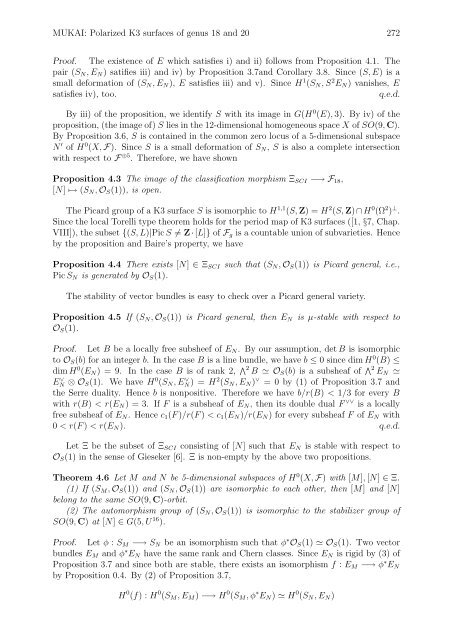Polarized K3 surfaces of genus 18 and 20 - Research Institute for ...
Polarized K3 surfaces of genus 18 and 20 - Research Institute for ...
Polarized K3 surfaces of genus 18 and 20 - Research Institute for ...
You also want an ePaper? Increase the reach of your titles
YUMPU automatically turns print PDFs into web optimized ePapers that Google loves.
MUKAI: <strong>Polarized</strong> <strong>K3</strong> <strong>surfaces</strong> <strong>of</strong> <strong>genus</strong> <strong>18</strong> <strong>and</strong> <strong>20</strong> 272<br />
Pro<strong>of</strong>. The existence <strong>of</strong> E which satisfies i) <strong>and</strong> ii) follows from Proposition 4.1. The<br />
pair (S N , E N ) satifies iii) <strong>and</strong> iv) by Proposition 3.7<strong>and</strong> Corollary 3.8. Since (S, E) is a<br />
small de<strong>for</strong>mation <strong>of</strong> (S N , E N ), E satisfies iii) <strong>and</strong> v). Since H 1 (S N , S 2 E N ) vanishes, E<br />
satisfies iv), too.<br />
q.e.d.<br />
By iii) <strong>of</strong> the proposition, we identify S with its image in G(H 0 (E), 3). By iv) <strong>of</strong> the<br />
proposition, (the image <strong>of</strong>) S lies in the 12-dimensional homogeneous space X <strong>of</strong> SO(9, C).<br />
By Proposition 3.6, S is contained in the common zero locus <strong>of</strong> a 5-dimensional subspace<br />
N ′ <strong>of</strong> H 0 (X, F). Since S is a small de<strong>for</strong>mation <strong>of</strong> S N , S is also a complete intersection<br />
with respect to F ⊕5 . There<strong>for</strong>e, we have shown<br />
Proposition 4.3 The image <strong>of</strong> the classification morphism Ξ SCI −→ F <strong>18</strong> ,<br />
[N] ↦→ (S N , O S (1)), is open.<br />
The Picard group <strong>of</strong> a <strong>K3</strong> surface S is isomorphic to H 1,1 (S, Z) = H 2 (S, Z) ∩ H 0 (Ω 2 ) ⊥ .<br />
Since the local Torelli type theorem holds <strong>for</strong> the period map <strong>of</strong> <strong>K3</strong> <strong>surfaces</strong> ([1, §7, Chap.<br />
VIII]), the subset {(S, L)|Pic S ≠ Z · [L]} <strong>of</strong> F g is a countable union <strong>of</strong> subvarieties. Hence<br />
by the proposition <strong>and</strong> Baire’s property, we have<br />
Proposition 4.4 There exists [N] ∈ Ξ SCI such that (S N , O S (1)) is Picard general, i.e.,<br />
Pic S N is generated by O S (1).<br />
The stability <strong>of</strong> vector bundles is easy to check over a Picard general variety.<br />
Proposition 4.5 If (S N , O S (1)) is Picard general, then E N<br />
O S (1).<br />
is µ-stable with respect to<br />
Pro<strong>of</strong>. Let B be a locally free subsheef <strong>of</strong> E N . By our assumption, det B is isomorphic<br />
to O S (b) <strong>for</strong> an integer b. In the case B is a line bundle, we have b ≤ 0 since dim H 0 (B) ≤<br />
dim H 0 (E N ) = 9. In the case B is <strong>of</strong> rank 2, ∧2 B ≃ O S (b) is a subsheaf <strong>of</strong> ∧2 E N ≃<br />
EN ∨ ⊗ O S (1). We have H 0 (S N , EN) ∨ = H 2 (S N , E N ) ∨ = 0 by (1) <strong>of</strong> Proposition 3.7 <strong>and</strong><br />
the Serre duality. Hence b is nonpositive. There<strong>for</strong>e we have b/r(B) < 1/3 <strong>for</strong> every B<br />
with r(B) < r(E N ) = 3. If F is a subsheaf <strong>of</strong> E N , then its double dual F ∨∨ is a locally<br />
free subsheaf <strong>of</strong> E N . Hence c 1 (F )/r(F ) < c 1 (E N )/r(E N ) <strong>for</strong> every subsheaf F <strong>of</strong> E N with<br />
0 < r(F ) < r(E N ). q.e.d.<br />
Let Ξ be the subset <strong>of</strong> Ξ SCI consisting <strong>of</strong> [N] such that E N is stable with respect to<br />
O S (1) in the sense <strong>of</strong> Gieseker [6]. Ξ is non-empty by the above two propositions.<br />
Theorem 4.6 Let M <strong>and</strong> N be 5-dimensional subspaces <strong>of</strong> H 0 (X, F) with [M], [N] ∈ Ξ.<br />
(1) If (S M , O S (1)) <strong>and</strong> (S N , O S (1)) are isomorphic to each other, then [M] <strong>and</strong> [N]<br />
belong to the same SO(9, C)-orbit.<br />
(2) The automorphism group <strong>of</strong> (S N , O S (1)) is isomorphic to the stabilizer group <strong>of</strong><br />
SO(9, C) at [N] ∈ G(5, U 16 ).<br />
Pro<strong>of</strong>. Let φ : S M −→ S N be an isomorphism such that φ ∗ O S (1) ≃ O S (1). Two vector<br />
bundles E M <strong>and</strong> φ ∗ E N have the same rank <strong>and</strong> Chern classes. Since E N is rigid by (3) <strong>of</strong><br />
Proposition 3.7 <strong>and</strong> since both are stable, there exists an isomorphism f : E M −→ φ ∗ E N<br />
by Proposition 0.4. By (2) <strong>of</strong> Proposition 3.7,<br />
H 0 (f) : H 0 (S M , E M ) −→ H 0 (S M , φ ∗ E N ) ≃ H 0 (S N , E N )
















